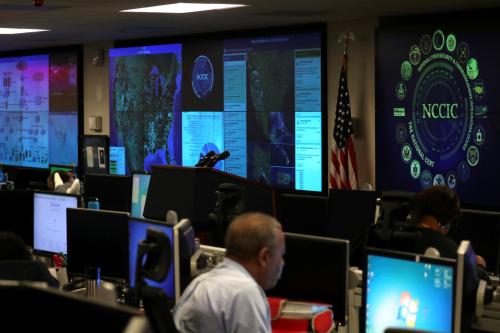The U.S. Navy recently made history with its flight of the X-47B UCAS, the first unmanned carrier drone (unmanned systems) to launch from an aircraft carrier. In 2009 and 2011, the Center for 21st Century Security and Intelligence at Brookings had the pleasure of hosting then Chief of Naval Operations, ADM Gary Roughead, to discuss the future of unmanned operations. The vision he laid out is well on its way to fruition, making it especially useful to place what happened today in the context of the larger U.S. defense strategy and to look at what lessons have been learned in the development of unmanned systems. As I explored in a look at the past and future of naval aviation after 100 years of flight, this success is only one part of a much bigger story.
What this history tells us is that, now that the Navy has crossed yet another step that the naysayers said could never be done, the challenges are as much organizational and political, as they are technical. For example, now that unmanned systems have shown they can fly off a carrier, what will be their exact role? Whether they will be delegated to take on tasks on their own or paired with manned planes, for a package that is greater than the sum of its parts, is a crucial question of naval air combat doctrine moving forward. It is akin to the questions that early warplanes faced as to whether they were to be tethered to the existing surface force of battleships as scouts or serve as their own, as a new form of a battle fleet.
We are only at the start of this robotic revolution at sea, just around the World War I stage of things, if manned airplanes are a parallel. Just as the first Navy planes started out doing only observation, but soon began to be used for everything from bombing runs to carrier onboard delivery (COD), so we are seeing a similar expansion in the roles of unmanned systems. UCAS originally started out being just in the observation ISR role, but clearly has a more lethal future, while the Marines are already using robotic helicopters for roles like cargo delivery in Afghanistan. But just like back then, we don’t yet have all the answers as to the optimal doctrine. Even the basic design of this technology remains to be learned and adopted.
A second lesson is that despite its relentless advancement, there are no signs that technology will end the central role of humans in war and at sea any time soon. However, not “ending”, isn’t the same thing as not “changing.” The specifics of the human roles will be altered, but again, this is nothing new. Most Navy warplanes today don’t have tail gunners or navigators. The skill sets and ranks of those who wear the wings of gold might be altered, which opens up the kind of internal identity and qualification questions in the Navy that have also recently challenged the Air Force. Does the remote operator (note: “operator,” not “pilot” is the terminology so far in the Navy, as opposed to how the Air Force views the requirement) of a plane that can take off and land on its own, who is sitting behind a computer screen, actually need 20/20 eyesight or the ability to do 50 sit-ups? Do they even need to be an officer (akin to how the Army has handled UAS versus the Air Force)? The next few decades will be an exciting time, with new paths being forged, much like they were by the first generation of naval aviation pioneers.
This leads to a third challenge that may be the most vexing to the Pentagon in the years ahead. In an article entitled U-Turn, I explored how there are a series of speed bumps that loom for unmanned systems, not so ironically just as they are making their mark. These range from internal cultural resistance to budgetary battles, in which the new is often disadvantaged against the old. We are seeing this play out here again. Few realize that (according to figures from the DoD UAs office), at the very same time the X-47 knocked down yet another technical barrier, the Navy’s planned UAS budget is being cut by 24%, several times greater than the rest of the budget cuts. Indeed, the tension that the successful UCAS test created for F35’s longer term buy numbers is much like Voldemort in the Harry Potter books, not to be spoken about, but palpable.
Bottom line: Congrats to the Navy and the team behind the X-47B on yet again making history, but this history tells us we have an array of questions to explore in the years ahead.
The Brookings Institution is committed to quality, independence, and impact.
We are supported by a diverse array of funders. In line with our values and policies, each Brookings publication represents the sole views of its author(s).



Commentary
Lessons and Context of the Navy’s First Carrier Drone Flight
May 15, 2013